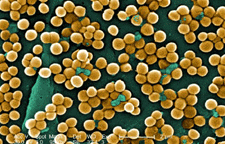
|
 |
MDRO - Multidrug-Resistant Organisms
MRSA (pronounced: mersa)
MRSA is an acronym for Methicillin-resistant
Staphylococcus aureus
|
|
This is the Methicillin-resistant
Staphylococcus aureus (MRSA) portion
of the multi-drug resistant organism module of OSHA’s Hospital
eTool. This electronic aid provides information (see
Disclaimer)
to help stop the spread of MRSA among employees and others working
in healthcare and other industries. Your local public health agency
has information on what your community is doing to prevent the
spread of MRSA. |
|
Since the mid 1970s, there has been a dramatic increase in the
proportion of Staphylococcus aureus (staph infections) caused by MRSA. MRSA infections are becoming
increasingly common among persons of all ages who previously were
considered to be at low
risk for this type of infection. Employers and employees in a
number of different industries have expressed concern about MRSA
infections in the
workplace and what they can do about it. MRSA colonization
and/or infections have
been reported in
healthcare employees and laboratory personnel, professional
athletes,
veterinarians,
pig farmers,
correctional facility personnel, and among
school staff. The information contained in these pages may help
you avoid becoming infected with MRSA while on the job.
 Staphylococcus aureus, commonly called "staph", is a
bacteria commonly found on the skin and in the nose of healthy
people. Sometimes staph can cause
infections. Most of the time, these are minor skin infections
that look like
pimples or
boils. A staph
skin infection is often red, swollen, painful and may have pus
or
fluid draining from the affected area. Sometimes the staph
bacteria can cause more severe infections in the lungs, heart,
bones, deep in the skin tissues, or spread throughout the body
through the bloodstream. Staphylococcus aureus, commonly called "staph", is a
bacteria commonly found on the skin and in the nose of healthy
people. Sometimes staph can cause
infections. Most of the time, these are minor skin infections
that look like
pimples or
boils. A staph
skin infection is often red, swollen, painful and may have pus
or
fluid draining from the affected area. Sometimes the staph
bacteria can cause more severe infections in the lungs, heart,
bones, deep in the skin tissues, or spread throughout the body
through the bloodstream.
 Methicillin-resistant Staphylococcus aureus,
or
MRSA, is a type of staph that is resistant to some
antibiotics. MRSA infections occur most frequently among persons in
hospitals and other healthcare facilities (such as nursing homes and
dialysis centers) who have weakened immune systems. These
healthcare-associated
(HA)-MRSA infections include infections of
surgical wounds, the urinary tract, bloodstream and lungs
(pneumonia). MRSA can also cause illness in persons
outside of hospitals and healthcare facilities. MRSA infections that
are acquired by persons who have not been
recently (within the past year) hospitalized or had a medical
procedure (such as dialysis, surgery, the insertion of a catheter)
are known as community-associated
(CA)-MRSA
infections. CA-MRSA infections are usually
manifested as skin infections, such as pimples and boils, and occur
in otherwise healthy people. However, some severe CA-MRSA infections
have also occurred in healthy individuals. Methicillin-resistant Staphylococcus aureus,
or
MRSA, is a type of staph that is resistant to some
antibiotics. MRSA infections occur most frequently among persons in
hospitals and other healthcare facilities (such as nursing homes and
dialysis centers) who have weakened immune systems. These
healthcare-associated
(HA)-MRSA infections include infections of
surgical wounds, the urinary tract, bloodstream and lungs
(pneumonia). MRSA can also cause illness in persons
outside of hospitals and healthcare facilities. MRSA infections that
are acquired by persons who have not been
recently (within the past year) hospitalized or had a medical
procedure (such as dialysis, surgery, the insertion of a catheter)
are known as community-associated
(CA)-MRSA
infections. CA-MRSA infections are usually
manifested as skin infections, such as pimples and boils, and occur
in otherwise healthy people. However, some severe CA-MRSA infections
have also occurred in healthy individuals.
More information on
HA-MRSA and
CA-MRSA can be found at the
Centers for Disease Control and Prevention (CDC) Web pages and
on Antimicrobial (Drug) Resistance at the
National Institute of Allergy and Infectious Diseases (NIAID) Web page. |
|
Disclaimer: This guidance is advisory in nature and informational in
content. It is not a standard or a regulation, and it neither
creates new legal obligations nor alters existing obligations
created by OSHA standards or the Occupational Safety and Health Act
(OSH Act). Pursuant to the OSH Act, employers must comply with
safety and health standards as issued and enforced
either by OSHA or by an OSHA-approved State Plan. In addition,
Section 5(a)(1) of the OSH Act, the General Duty Clause, requires
employers to provide their employees with a workplace free from
recognized hazards likely to cause death or serious physical harm.
Employers can be cited for violating the General Duty Clause if
there is a recognized hazard and they do not take specific steps
to prevent or abate the hazard. However, failure to implement any
recommendations in this guidance is not, in itself, a violation of
the General Duty Clause. Citations can only be based on standards,
regulations, or the General Duty Clause. |
|
|

